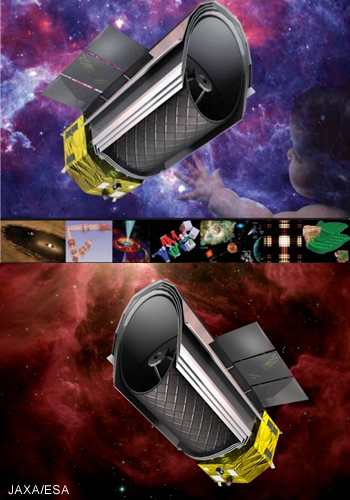Space Infrared Telescope for Cosmology and Astrophysics (SPICA)
SPICA (the SPace Infrared telescope for Cosmology and Astrophysics) is a next-generation infrared space telescope, built by a Japanese-led international consortium, which also involves ESA, Korea and Taiwan. SPICA is an actively cooled (to 5K) 3.5m telescope, which will operate from 5-210 micron, with a possible extension into the NIR. Its size is comparable to the Herschel Space Telescope but since that telescope is only passively cooled, SPICA is expected to operate at much better sensitivity levels. SPICA's launch date is anticipated for the early to mid 2020s, and as such, it will be launched after the James Webb Space Telescope. While there is overlap shortwards of ~25 micron, SPICA uniquely accesses the longer wavelength range until 210 micron. In addition, SPICA is more sensitive than JWST at wavelengths longer than 20 micron, and it has a much larger field-of-view, and thus superior mapping capabilities.
 Three main science objectives are defined for SPICA:
Three main science objectives are defined for SPICA:
- Formation and evolution of planetary systems: Gas and dust in proto-planetary discs, including water, and their link to planetary formation; mineralogy of debris discs; gas exoplanets atmospheres; composition of Kuiper Belt objects.
- Life cycle of dust: Physics and chemistry of gas and dust in the Milky Way and in nearby galaxies; dust mineralogy; dust processing in supernova remnants and the origin of interstellar dust in the early Universe.
- Formation and evolution of galaxies: AGN/starburst connection over cosmic time and as a function of the environment; co-evolution of star formation and super-massive black holes; star-formation and mass assembly history of galaxies in relation with large scale structures; the nature of the Cosmic Infrared Background.
At this time, four instruments are being developed. ASIAA is involved in the development of the Mid-Infrared Camera and Spectrograph (MCS), which is led by ISAS. This instrument has a wide field camera mode capable of imaging in ~16 bands from 5 - 40 micron, and also has a medium resolution spectrometer (MRS), which will operate from 12.2 - 37.5 micron at R = 2,000 - 3,000, and a high resolution spectrometer (HRS-L), which will operate from 12 - 18 micron at a spectral resolution of R = 20,000 - 30,000. The exact filter set for the WFC has not quite been decided upon, but will probably include some grism mode to offer low resolution spectroscopy (R = 50 - 200) over the full wavelength range, including the 5 - 12 micron wavelength range, not otherwise covered by the spectrometer modes. Other focal plane instruments are the coronograph (SCI), developed by ISAS; the near-infrared camera and spectrometer (FPC), developed by Korea; and SAFARI, the far-infrared Fourier Transform Spectrometer, developed by a European consortium led by SRON in the Netherlands.
Project Members (5)
Journal Papers (7)
- Otsuka M*; Kemper F; Leal-Ferreira ML; et al., "XSHOOTER spectroscopy of the enigmatic planetary nebula Lin49 in the Small Magellanic Cloud" , MNRAS: 462(1), 12-34, Oct 10, 2016 [SCI] ( ADS | Fulltext )
- Takami M; Tamura M; Enya K; et al., "Studies of expolanets and solar systems with SPICA" , Adv Space Res: 45(8), 1000-1006, Apr, 2010 [SCI] ( ADS | Fulltext )
- Kamp I; Honda M; Nomura H; Audard M; Fedele D; Waters LBFM; Aikawa Y; Banzatti A; Bowey JE; Bradford M; Dominik C; Furuya K; Habart E; Ishihara D; Johnstone D; Kennedy G; Kim M; Kral Q; Lai SP; Larsson B; Mcclure M; Miotello A; Momose M; Nakagawa T; Naylor D; Nisini B; Notsu S; Onaka T; Pantin E; Podio L; Riviere Marichalar P; Rocha WRM; Roelfsema P; Santos F; Shimonishi T; Tang YW; Takami M; Tazaki R; Wolf S; Wyatt M; Ysard N, "The formation of planetary systems with SPICA" , PASA: 38, id. e055, Nov, 2021 [SCI] ( ADS | Fulltext )
- Roelfsema PR; Shibai H; Armus L; ...; Kemper F; et al., "SPICA-A Large Cryogenic Infrared Space Telescope: Unveiling the Obscured Universe" , PASA: 35, id.e030 (17 pp.), Aug, 2018 [SCI] ( ADS | Fulltext )
- van der Tak FFS; Madden SC; Roelfsema P; ...; Kemper F; et al., "Probing the baryon cycle of galaxies with SPICA mid- and far-infrared observations" , PASA: 35, e002, Jan, 2018 [SCI] ( ADS | Fulltext )
- Kataza H; Sakon I; Wada T; ...; Ohyama Y; et al., "Performance Estimation of the Mid-Infrared Camera and Spectrometer Aboard SPICA" , JAI: 4(1-2), id. 1550001, Jun, 2015 ( ADS | Fulltext )
- Enya K; Kotani T; Haze K; ...; Takami M; et al., "The SPICA coronagraphic instrument (SCI) for the study of exoplanets" , Adv Space Res: 48(2), 323-333, July, 2011 [SCI] ( ADS | Fulltext )
